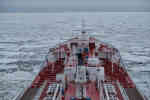Step 1 of 5•9 minutes read
Propulsion and Steering Systems used in Polar Waters
Propulsion systems on ice-classed vessels tend to be similar to those of other vessels. However, the propeller and rudder (if fitted) will be protected with more steel, such as posts or containers to minimise the risk of damage caused by contact with ice. Therefore, as mentioned before, primary and auxiliary means of steering provided onboard such ships should be of adequate strength and design to be able to function efficiently in polar waters.
Traditional Propeller and Rudder Systems
Polar vessels tend to have controllable-pitch propeller systems. These benefit from being easily reversible and providing immediate power when applied. There is also the advantage that even when at zero pitch, the propeller continues to turn. This tends to keep the area clear of floating ice that may accumulate with fixed-pitch propellers when these are stopped in the water.
It is common to have significant cladding and protections for the propeller. This extra steel does not affect the performance overly, but it is there to ensure that larger pieces of floating ice do not strike the propeller directly. This is usually tied into the rudder stock to further protect the rudder similarly. This forms a system similar to traditional unbalanced rudder construction types but with more protection afforded for the vital propulsion components.

A vessel navigating in Ice. Photo: Jörgen Språng
Azimuth Drive
More modern vessels and newer constructions have been emphasizing the use of azimuth drives and azimuth propulsion systems for ice-class vessels and icebreakers. These systems have some significant advantages over traditional propulsion drives, especially in polar waters.
The azimuth drive system is a combined rudder and propeller, which means fewer components may be damaged by ice. They are also situated under the hull, in more protected areas, which reduces their exposure to ice and therefore reduces the likelihood of damage. The propellers also tend to be housed in cladding as standard to generate laminar flow which also further protects the system without the need for additional bracing.
Azipod-driven ships also benefit from heightened manoeuvrability, especially in icy waters. Not having an exposed rudder, the vessel is more able to operate astern propulsion without undue fear of damage. This is a considerable advantage in polar waters.
Engineering Systems and Machinery
Any engineering system onboard should be capable of withstanding navigation in polar waters. This includes the following:
Rating
Installation
Design
Operation
Maintenance of such a system
The machinery which is essential for the safe operation of the specific ship should be provided with adequate ventilation systems supplying the air at the right temperature. Main propulsion machinery together with the auxiliary machinery is required to be designed in a way to withstand any loads and vibrations that might be imposed by the propeller, hull, and rudder upon interaction with ice. These should also be capable of operating even at angles of heel or trim that might be suffered by the ship during operation in cold environments.
Any piping and intake systems associated with all propulsion machinery are required to be designed in a way to not be affected by these extreme conditions. When it comes to the location of this machinery, it should protect any spray, ice, and snow.
Any essential equipment or system that is deemed required to ensure the safe operation of the specific ship or any systems provided onboard for preventing pollution, if located in spaces that might be subject to the extreme temperature outside, should be provided with an independent heating system in the case of failure of the primary heating system, to avoid them being affected by the cold environment. The material of such equipment should also be strong enough to not be affected by a brittle fracture due to the loads and temperatures.
More information can be found in Resolution A.1024(26) Guidelines for Ships Operating in Polar Waters.